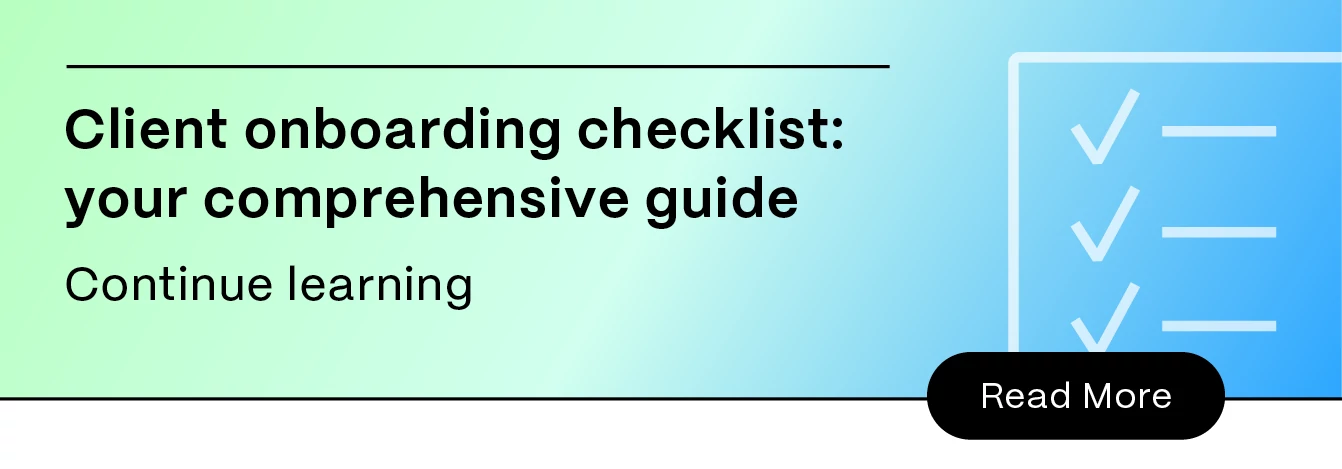
Blog
Wealth management client onboarding process + checklist

If you ever find yourself asking, “what do wealth management clients want?”, you're not alone. The answer may be different depending who you ask, but two things are certain — they expect services to be delivered on time and to be kept in the loop. Fulfilling this expectation starts with a comprehensive, tech-enabled, and streamlined wealth management client onboarding process.
This article explores the importance of a strong client onboarding process. It also offers comprehensive checklists you can use in the client acquisition strategy for your wealth management business.
Importance of a strong client onboarding process in wealth management
In wealth management, client onboarding is about introducing clients to financial advisors while collecting the necessary information to develop a wealth management strategy.
Relationships with clients should be long-lasting, two-way partnerships built on trust. Because new clients don’t have a history with your business, they may reconsider working with you if the onboarding process is too overwhelming, difficult, or time-consuming. That's why wealth management client retention depends on a straightforward onboarding process that sets the right tone for your professional relationship from day one.
Generally, onboarding new clients consists of three phases:
- Collecting financial information: Gather key details to understand your client’s current financial situation. It’s important to collect all the information you need upfront to avoid sending multiple one-off requests that can inconvenience clients.
- Establishing goals: Gain an understanding of your client’s financial goals and priorities so you can build a strategy that aligns.
- Setting expectations: Discuss what you and your team are capable of doing to help clients reach their goals. Setting clear expectations ensures clients have a realistic understanding of your capabilities, avoiding confusion about what’s achievable.
For each phase of client onboarding, establishing an effective, streamlined process can lead to a number of benefits, including:
Higher client satisfaction
A positive client onboarding experience provides a strong foundation for a long-term working relationship. Clients who are pleased with their introduction to your firm are more likely to stay well beyond the onboarding process.
Business growth through referrals
If clients are satisfied with the onboarding experience, they’re likely to refer your firm to friends and colleagues — and referrals are a major contributor to how wealth managers get clients.
According to one survey, 48% of wealth managers said referrals are the best way to get new high-quality clients, and 43% stated their top five clients came from referrals. In a competitive business landscape, success is heavily influenced by your reputation and current client reviews.
Improved efficiency
Streamlining the information-gathering process during onboarding significantly improves efficiency by collecting all necessary details upfront. Disorganized or staggered requests for information can cause unnecessary frustrations, so it’s crucial to maintain a seamless and professional approach throughout the onboarding process.
Related read: Accelerate and Optimize Client Onboarding
Checklist: Building a better onboarding process for wealth management clients
Ready to establish a wealth management client onboarding process that gets clients excited to work with you? Read on for five steps and checklists to create and execute an effective onboarding strategy.
Step 1: Map out the client onboarding journey
Earlier we identified three phases of client onboarding: collecting information, establishing goals, and setting expectations. The first step in creating the best possible onboarding process is mapping out the ideal experience for each of these phases, taking both your needs and the client’s perspective into account.
By anticipating clients’ needs at the onboarding stage, you build trust, maintain satisfaction, and set the foundation for a strong, long-term working relationship. Beyond this, you’ll also need to consider how to collect necessary information and ask questions that set you up for a successful partnership.
Checklist
Use this checklist to map out the ideal client journey and improve your firm’s onboarding process:
- Create a list of FAQs that new clients typically ask and document how your firm would answer.
- Identify resources clients will need from you and what specific information you’ll need to collect at each stage of the onboarding process. This should include collecting financial information, establishing goals, and setting expectations.
- Determine appropriate timing forwhen to answer FAQs, collect client information, and deliver the resources clients need.
- Identify the most effective communication channels to collect and deliver information, whether through email, phone calls, or other digital platforms.
- Build a detailed onboarding workflow that maximizes efficiency, leveraging the steps outlined above.
- Use workflow management technology to standardize, streamline, and monitor the onboarding process.
Step 2: Choose the right onboarding software
Once you’ve established the ideal onboarding process for your firm and clients, finding the right tech solution is the next step. Workflow onboarding tools offer several features that support the different stages of onboarding, from creating and signing documents online to automating workflows. Opting for software that aligns with your firm’s ideal client onboarding journey will further streamline and expedite the process.
With the right technology, you can make client onboarding simple and effective.
Checklist
As you assess client onboarding software, make sure it includes the following features for a smooth and professional process:
- A client portal that provides a centralized digital hub for clients to securely access all of their onboarding tasks and documents in one place.
- Communication tools such as commenting features within the portal and documents to encourage seamless collaboration.
- Customizable alerts that the client can set to help stay on top of onboarding tasks.
- Built-in automation for standard onboarding workflows to maximize efficiency.
- Use 256-bit encryption for all messages and documents to protect client’s personal identifiable information (PII) and privacy.
- User-friendly interfaces that let your teams quickly configure the system according to client preferences.
- Quality customer service from vendors supports a smooth implementation process and helps you get the most out of your software investment.
Related read: What is Client Portal and Why is it Important?
Step 3: Focus on security and compliance
Because onboarding involves collecting sensitive financial data and other confidential client information, it’s crucial to uphold security standards and adhere to the latest regulatory requirements.
Onboarding software with built-in compliance checks can help keep track of ever-evolving legal regulations. It’s also important that clients know you follow these guidelines so they can be confident you’re safeguarding their information and adhering to regulations.
Checklist for security and compliance
Use this checklist to make sure you’re covering every aspect of security and compliance during client onboarding:
- Assess current software to determine how it handles compliance and updates to regulations. If your current software is lacking in compliance support, consider a different solution.
- Use security features when collaborating on onboarding documents with clients, such as access controls, two-factor authentication, 256-bit encryption, and document password protection.
- Collect client signatures electronically, as e-signatures are more secure compared to traditional wet signatures.
Step 4: Schedule a live consultation
While automated tools and platforms are useful for collecting client information and sharing resources, no onboarding process is complete without human involvement. A live meeting can be a great opportunity to talk through client goals and address any remaining questions. And given that personalization often drives a 10-15% revenue increase for companies, creating a more personalized onboarding experience through a live conversation makes good business sense, too.
Live meetings are also important when strategizing for complex situations that can’t be fully addressed through a standardized process. High-net-worth individuals, in particular, often require customized wealth management strategies. For these clients, scheduling multiple live meetings — whether in-person or virtually — may be necessary to provide adequate support throughout the onboarding process.
Checklist for live consultations
Use this checklist to get the most out of a live consultation:
Before the meeting
- Gather essential client information using a standard questionnaire.
- Conduct research to get a complete picture of the client’s priorities and goals.
- Schedule an initial meeting based on the client’s date, time, and location preferences.
- Create an agenda to keep the discussion on track and ensure all topics are covered.
- Collect client input by asking if there are specific topics they’d like added to the agenda to discuss.
- Confirm the meeting with the client to avoid an accidental no-show.
During the meeting
- Start by introducing yourself and your experience, chatting with the client informally to create a comfortable atmosphere.
- Follow your prepared agenda to touch on all the topics you and your client would like to discuss.
- Take notes by documenting what’s being discussed during the live meeting.
- Record the call — with the client’s permission — to more accurately document the conversation for future reference.
After the meeting
- Send a note thanking the client for their time.
- Briefly recap what you discussed during the meeting and outline clear next steps.
- Provide the client with a summary of your notes as an easy reference for what was discussed.

Step 5: Collect feedback and optimize the process
Even with thoughtful planning, issues can arise. Each client is unique and may face challenges you hadn’t anticipated. Improve your onboarding approach by learning from experience and continually optimizing the process based on feedback.
Take feedback seriously and use it as an opportunity to enhance processes, contributing to stronger wealth management client acquisition strategy and wealth management client retention. It’s also important to think critically and assess processes on your own to identify opportunities for further efficiencies and improvements.
Checklist for collecting client feedback
Use this checklist to make sure you’re collecting comprehensive client feedback and implementing it appropriately:
- Consistently request feedback by including a client feedback request in your onboarding process.
- Prepare questions to help clients give feedback, such as 1-to-10 rating scales or free-writing prompts.
- Centralize feedback in a digital hub so client suggestions are accessible to your entire team.
- Gather team input, providing opportunities for advisors and other team members to suggest process improvements.
- Review feedback regularly and appoint stakeholders to decide on adopting suggestions or making changes.
- Implement changes to improve efficiency, staff productivity, and client satisfaction.
- Communicate changes to all staff involved in the onboarding process to help ensure new processes are followed.

Build a better onboarding experience for wealth management client retention
As the first point of contact with wealth management clients, onboarding is crucial for establishing trust and satisfaction from the start. By following the steps and checklists in this guide, you can develop a process that leads to more referrals through word-of-mouth, improved client retention, and better overall efficiency.
In the finance industry, every aspect of the client experience counts. Demonstrate your competence upfront with an excellent onboarding process, so you can go on to impress with the results you bring.
Related Resources
